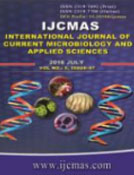


 National Academy of Agricultural Sciences (NAAS)
National Academy of Agricultural Sciences (NAAS)

|
PRINT ISSN : 2319-7692
Online ISSN : 2319-7706 Issues : 12 per year Publisher : Excellent Publishers Email : editorijcmas@gmail.com / submit@ijcmas.com Editor-in-chief: Dr.M.Prakash Index Copernicus ICV 2018: 95.39 NAAS RATING 2020: 5.38 |
The global incidence of Candidiasis has risen steadily over the past few decades. Candida species are now among the most common health care –associated pathogens. Most of the studies show that the predominant species C. albicans has been replaced by non albicans Candida with the use of antifungal agents. As various species differ in susceptibility pattern to the newer antifungal agents, antifungal susceptibility test should be performed before administration of antifungal agents. To isolate and identify different Candida species in various clinical specimens, to know the predominant species, to study the risk factors, to compare the advantage of rapid method such as use of Chrom agar over conventional methods for identification and confirmation of Candida species and to detect their antifungal susceptibility pattern. All the clinical samples collected from cases of candidiasis were processed initially using blood agar, MacConkey bile salt lactose agar and SDA with chloramphenicol. Cultures that are identified as candida species were processed using standard yeast identification protocol and chrom agar. Patient detailed clinical history including risk factors was noted. Antifungal susceptibility testing of the yeast isolates was assessed using agar disc diffusion method according to CLSI guidelines. The antifungal drugs used for disc diffusion method are - amphotericin B, Nystatin, fluconazole, Voriconazole, ketaconazole & clotrimazole. A total of 150 Candida isolates were subjected to speciation & antifungal susceptibility testing. Candida isolates were present in 94 (62.6%) males and 56 (37.3%) females. Prolonged use of antibiotics was the major risk factor 41 (27.3%) followed by Biomedical devices 32 (21.3%), Medical causes 21(14%), Diabetes mellitus 17 (11.3%), Trauma 14 (9.3%), Surgical causes 11 (7.3%), Pregnancy 7(4.7%), birth asphyxia 5 (3.3%) and HIV 2 cases (1.3%) respectively. A total of 90 (60%) isolates were obtained from urine, respiratory samples 26 (17.3%), Blood 16 (10.7%), High vaginal swabs 14 (9.3%), wound swabs 4 (2.7%) respectively. In our study Non albicans candida species are more in number over C. albicans. Among Non albicans Candida, C.tropicalis isolation is more, 86 (57.33%). The sensitivity and specificity of CHROM agar was found to be 100% for C.albicans. For C.tropicalis the sensitivity was 100% & specificity was 95.3%. All the isolates of Non albicans Candida were susceptible to Amphotericin B, Nystatin, Voriconazole, Clotrimazole, Itraconazole& Fluconazole. But some species of NAC like C.guilliermondii and C.lipolytica which showed 40% and 33.4% resistance. 22% of strains of C.tropicalis showed resistance against Fluconazole. C.famata showed complete resistance to fluconazole, clotrimazole, Itraconazole, whereas C.dubliniensis & C.guilliermondii showed 33.4% and 40% resistance to Fluconazole. C.albicans showed 100% susceptibility to Amphotericin B & nystatin followed by Ketoconazole (83.3%), Voriconazole (76.6%), Itraconazole (75.8%), Clotrimazole (71.6%) and Fluconazole (63.3%) respectively. Isolation of non – candida albicans species was more than Candida albicans. The predominant species isolated in our study was C .tropicalis. Chrom agar candida medium was found to be useful in identification of candida species. All candida isolates were sensitive to amphotericin & nystatin The antifungal resistance was more in the non albicans species than in Candida albicans. Hence there is a need for speciation, susceptibility testing & periodic surveillance of candida species.
 |
 |
 |
 |
 |